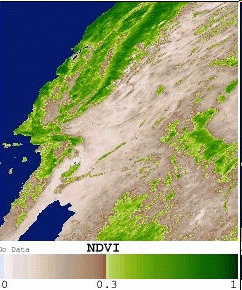4.1 - NDVI
As detailed in chapter 3, the relationship of red and NIR reflected energy is clearly related to the amount of vegetation present on the ground (Huete et al. 1999). Reflected red energy decreases with plant development due to the chlorophyll absorption within actively photosynthetic leaves. Reflected NIR energy, on the other hand, will increase with plant development through scattering processes in healthy leaves.
The most widely used VI is the Normalized Difference Vegetation Index, it consists of a normalized ratio of the NIR and red bands
Where:
ρred and ρNIR (either top of atmosphere or surface bidirectional) are the reflectance measurements for VIS red and NIR bands, respectively.
For land targets the index ranges from values close to 0 for arid or barren areas to ~ 1 for densely vegetated areas. Negative values of NDVI usually correspond to urban areas. The NDVI over water surfaces is very close to -1 due to their very low reflectance in the NIR band.

Figure 4.1: MODIS/Terra Vegetation NDVI 16-Day L3 Global 250m SIN Grid.
NDVI main advantages and disadvantages.
Advantages:
- As a simple transformation of spectral bands, NDVI is easily computed without assumptions regarding land cover classes, soil type or climatic conditions
- Long time series (more than 20 years) available.
Disadvantages:
- Inherent nonlinearity because it is a ratio based index
- Additive noise effects
- Asymptotic (saturated) signals over high biomass conditions
- Very sensible to canopy background brightness (Huete, 2002)
- Is not a structural property of a land surface areas
